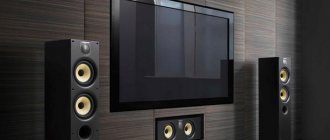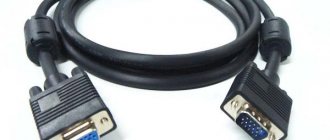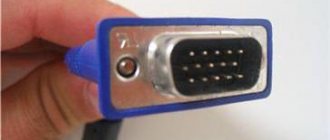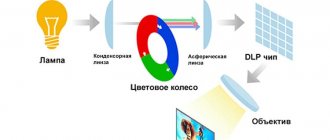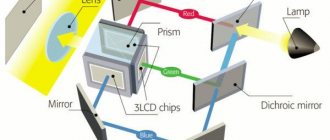A post about how I learned Zen and began to have a new attitude towards budget projectors.
Speaking about a real Home Cinema (that’s right, with a capital “H”)
, we usually imagine a comprehensive solution, including interior design, acoustic preparation of the room, and installation of a multi-channel sound system. Well, the “cherry on the cake” is a cool projector such as the Epson EH-TW9400, because it is the projectors of the nine thousandth series that year after year show themselves excellently when compared even with noticeably more expensive top-level models, and have gained the reputation of “affordable High End”.
But what happens if you compare these “celestials” side by side with the most budget home projector in the Epson line
?
For the very interesting results of my personal comparison of two such devices, please see cat.
Why and which projectors were compared?
The very idea of such a comparison seems to be a little “against the rules”, because projectors have completely different “weight categories”. And in general, which brand’s blog will you read about how, instead of a “fat” flagship, it makes sense to look towards a much more budget-friendly one, such as, for example, the Epson EH-TW650 (blog post)?
However, I don’t see anything “unnatural” in testing the assumption that for less money you can get a completely sensible device at your disposal. And you shouldn’t underestimate, or even deliberately belittle, the capabilities of entry-level projectors.
In comparison, models such as the Epson EH-TW5650 (blog post) and Epson EH-TW7100 (blog post) will also be mentioned here and there. However, I did not focus on them, because everything has already been described in the corresponding blog posts about them, and it is much more interesting to compare the “two extremes”.
The comparison was carried out in the Pult.ru demo zone, which has a cool darkened cinema room with a 260 cm wide screen. The screen diagonal is 117 inches, the surface is matte, with perforations for acoustic transparency. This diagonal allows you to achieve an excellent immersive effect, but is noticeably more demanding on the brightness of the projector than such popular options as 80 and 100 inches.
In total, the following people took part in testing:
- The flagship Epson EH-TW9400 costs around 2700 USD;
- "State employee" Epson EH-TW650 priced at ~$600.
Projector Disadvantages
- A well darkened room is required. A high-quality image can only be obtained in pitch darkness.
- Not all TV shows are broadcast digitally. Watching a movie in HD format will certainly be a pleasure, but watching programs broadcast on analogue TV channels with insufficiently clear images will be uncomfortable.
- Projector lamps have a limited lifespan and replacing them will incur additional costs. Even for modern high-quality models, this parameter does not exceed 5000 hours.
- You must purchase speakers separately for sound output.
- There is a slight noise when the projector is operating, which is created by a fan to cool the system.
Image and color quality
"State Employee" Epson EH-TW650 and 117-inch diagonal image
I’ll say right away that all the projectors under consideration could easily cope with such a diagonal, even in the maximum color accuracy mode, because have a luminous flux of 2500 to 3000 lm.
However, there is a nuance: models with HDR support (Epson EH-TW7100 and EH-TW9400) have a slightly more powerful lamp - 250 watts versus 200-210 watts for entry-level projectors, which is logical, because HDR projectors need to have the power to produce turbocharged brightness in scenes with a wide dynamic range. And in accurate color mode, you should expect some reduction in luminous flux from all projectors (regardless of brand).
At the same time, with any projector chosen for testing, we in any case get a large, bright and colorful image (this is not some kind of “old-fashioned” slide projector). In addition, it seems to me that without the installation of side-by-side projectors, most viewers would not be able to immediately determine which image was being shown at the moment upon entering the room, since for this to happen the image would have to contain noticeable, conspicuous inaccuracies or even “defects.” " And here they are not
.
Epson EH-TW650:
Epson EH-TW9400:
I must admit that the screenshots did not allow us to convey the difference visible to the eye, primarily in contrast and black depth (the images were not color corrected, and I do not want to “fake” them).
I will also note that I enjoyed looking at all the projectors in the high lamp power mode, where I, however, immediately noticed a more audible operation of the cooling system of the entry-level projector in this mode.
Can I use a budget projector to watch movies?
Many of us are accustomed to the fact that projectors outside of cinemas are used mainly in offices and educational institutions. Indeed, delivering presentations and training materials using these devices has long become the norm. But they enter everyday life much more slowly.
The main reason is the lack of aggressive marketing and the fairly high cost. For most consumers today, TVs with a diagonal of 40 (maximum 50) inches are sufficient. And these are quite budget devices by modern standards, despite the mediocre quality.
The projector allows you to organize viewing of your favorite films and programs on a diagonal of 2 meters or more on a fairly budget (however, everything is relative). But in order for the image to be more or less high quality, you will have to spend up to 50 thousand rubles. And you need to understand that the result will still be quite far from the cinematic one. In addition, you will have to put up with a number of inconveniences, which we will talk about later.
Color accuracy and color gamut
Anticipating how you shake your head, looking at the two pictures above that don’t say much, I’ll say a few words about the results of an “objective” assessment of the color rendition of the considered models using instruments. I tried to keep it brief, but if you don’t want to delve into the details, just skip this paragraph.
The standard is the “HD standard” Rec.709, and the deviation from the standard is measured in special units (Delta E, CIE94). Every home projector must have a color mode “tailored” to the standard. For the Epson EH-TW650 it is called “Game”, and for the rest of the participants, including the Epson EH-TW9400, it is called “Neutral”.
A color is considered accurate if Delta E is less than 3.
Color charts allow you to visualize the accuracy of individual colors
As a result of measuring 100 colors, I obtained interesting results: the average error for both models was in the range from 2 to 3. Of course, the Epson EH-TW9400 was initially the most accurate (cf. Delta E = 2.26), and it is better suited than others for professional calibration, allowing the error to be reduced to negligible levels. However, the result of the Epson EH-TW650 was also very good:
average Delta E = only 2.49!
Yes, it has its own “innate” weaknesses associated with blue and 100% green, but you can’t argue with the numbers - on average, color accuracy is exceptionally high, and in most cases the Epson EH-TW650 should not differ much from the Epson EH- TW9400 in terms of
color accuracy
We’ve sorted out the measurements, but there’s still no escape from comparisons based on subjective sensations, that is, when viewing real content with your own (in this case, my) eyes.
TVs: traditional and familiar
Along with film fans and professionals who prefer video projectors, there are fans of television equipment. For them, the answer to the question: what is better for the home – a TV or a projector – is not difficult. Definitely TV! A wide-screen film can also be viewed in a cinema. TVs, familiar to everyone, are undoubtedly irreplaceable and convenient, and have their own advantages and disadvantages.
Resolution: 1080p or 4K/HDR?
In this comparison, I rate a budget projector for the "average" person who needs a workhorse for viewing a wide variety of content. Those. Full HD resolution is quite enough. Yes, of course, flagship models like the EH-TW9400 have 4K Enhancement technology for outputting 4K content on a 1080p matrix and leveling the pixel grid. But to be honest: on a 117-inch screen, from a distance of more than one and a half meters, the grid of pixels in a 1920x1080 picture cannot be seen. And why then overpay?
I was also curious to see how a top projector would cope with “regular content”, which included various demo videos and film fragments, with different bitrates, incl. on YouTube, because the owner of even the most expensive device will not watch exclusively 4K HDR BluRay releases on it, right? If we take an analogy with cars, then I look at the behavior of an “elite foreign car” on “domestic roads”.
As I already said, the feeling of “naturalness” of the image on the Epson EH-TW9400 consists of many factors. This “naturalness” affects the perception of the most ordinary scenes, which become interesting precisely because they are perceived “as they should.” What do you think of these arguments?
Here, for lack of anything better, a word comes to mind that is often used by Western projector reviewers - image “clarity”.
As with most things, the photographs don't do justice to the most significant differences between the two projectors.
Epson EH-TW650:
Epson EH-TW9400:
For example, the strength of the Epson EH-TW650 is the quality of rendering smooth color transitions and halftones, which perfectly complements the good accuracy of color shades and the richness of colors. However, flying over the snowy mountains turned out to be a difficult test for this model, because you have to look at “ordinary” shades of white.
At the same time, in the “Cinema” mode, the Epson EH-TW9400 makes even this scene more dynamic and impressive. And this despite the fact that the video is saved in SDR, not HDR! When rendering leaves and flowers swaying in the wind, the Epson EH-TW9400 gives a sense of presence and “hyperrealism” (hello, Michael Bay!)
, whereas on the Epson EH-TW650 these scenes looked somehow too “formal”... Like on a monitor screen. However, there were also numerous scenes that this projector quite successfully filled with life, although, of course, without much chance of catching up with the Epson EH-TW9400, which “can” handle the DCI color space and generally supports HDR.
Projector Installation Features
It would seem that a projector is a simple and compact piece of equipment that is easy and simple to install. For proper installation, you need to consider some points:
- If you use a white wall as a screen, if you have one, then that's one less problem. It is possible to install a stationary screen if there is a room specially designated for the cinema. A convenient solution is to install a roll-up screen with automatic deployment. Of course, this option involves certain time and financial costs, but it is worth implementing - the comfort of use will more than pay for all the efforts. Moreover, for such a screen it is not necessary to use a wall - it can be installed in any convenient place, even in the middle of the room.
- Installing the projector itself will not cause any particular difficulties: it can be placed on any table or cabinet, its compact size makes this easy to do. But if you hang the device from the ceiling or mount it at a higher level so that viewers do not fall under the beam of the projector, then comfortable viewing will be ensured.
- Providing cable communications also poses some problems for connecting acoustics and connecting the projector to the player. The current limitation on the length of an HDMI cable, 15 meters, does not allow it to be laid unnoticed. You will have to use a longer cable, which will affect the quality of the transmitted image. But if you use WHDI wireless technology, which efficiently transmits digital signal and sound up to 30 meters, then this problem will be solved.
Contrast
Now, finally, let's talk about contrast (after all, the Epson EH-TW9400 has 10 or more times higher “according to the passport”).
A little hint for those who don’t know about the Epson line:
- the first “qualitative leap” in native contrast occurs on the Epson EH-TW5650 model (it is significantly higher than that of the EH-TW5600, see blog post on the topic);
- the second is for the Epson EH-TW7100 projector (including in comparison with the EH-TW7000). However, the EH-TW9400 has the most impressive contrast gap over all previous models.
In general, in fact, I’m comparing the projector with the smallest and largest
contrast!
But how exactly does high contrast affect when viewing real content
?
A review showed that, oddly enough, the depth of black color itself is not the main difference. Given the overall accuracy of the picture (without strange shades in transitions, “dips” in shadows, etc.), even a relatively elevated black level is not annoying. Although, of course, dark scenes are an important measure of the “class” of a projector. But this is not the main thing. First of all, high contrast gives light, bright scenes a greater “naturalness”, a greater sense of realism, depth and volume. Combined with high brightness, all this makes the Epson EH-TW9400 an enviable HDR projector. Accuracy combined with deep blacks allows you to achieve spectacular and “life-like” images even within the limitations of good old HD/SDR content with average bitrates.
On dark scenes, the devil is also in the details. Personally, one scene in “The Dark Knight” caught my eye: a commando runs down the stairs in complete darkness, and the light of a flashlight glides across his face. The Epson EH-TW650 can accurately convey many scenes where there is shadow and bright light at the same time, but not this one! Here, the Epson EH-TW9400 really helps highlight facial features in that small highlighted area without overexposing them or losing detail. And this is not something sensational - just an ordinary flashlight in the dark.
Epson EH-TW650:
Epson EH-TW9400:
Another scene.
Epson EH-TW650:
Epson EH-TW9400:
The raised black level of one of the projectors is clearly visible, like the notorious “glow” of IPS matrices (the images have not been color corrected). At the same time, the Epson EH-TW9400 actually does not have such loss of detail in dark shades as in the photo. It’s just that the difference in brightness when moving from bright to dark areas is so strong that the picture from this device “did not fit” into the dynamic range of the camera. More precisely, it fit, but only inside a 14-bit RAW file. I could restore these details by re-developing the file in the editor, but then the comparison would no longer be fair. That’s why we compare sRGB JPGs vs JPGs everywhere, where each has around ~7 “stops” of dynamic range.
Let me make an important note:
when switching from Epson EH-TW9400 to Epson EH-TW650, gradual adaptation occurs,
and after half an hour the dissatisfaction with the decrease in the overall image level disappears.
Oddly enough, black color ceases to be a “problem”: you quickly get used to the black level, but you still feel a certain general loss of realism after the picture from the 9400.
How to choose a projector for your home using 5 criteria
To choose a worthy replacement for a TV, you need to take into account several important criteria. We'll tell you about each in detail.
Permission
Determined by the number of pixel points that line up the frame in width and height. Indicated by two numbers. The larger they are, the clearer the picture. And also a larger screen diagonal size, where you can watch it without losing quality. A resolution of 800x600 can provide viewing of DVD-quality multimedia, nothing more. For HD content, select a value of at least 1920x1080. The 4K format requires a resolution of at least 3840x2160.
2. Format or aspect ratio
Multimedia is used not only for playing games or watching movies, but also for showing slides, presentations, etc. Therefore, the aspect ratio of the frame may be different. For a home cinema, it is best to choose the 16:10 or 16:9 format. But the 4:3 ratio will not work; it is convenient for demonstrating documents, graphs, and presentations.
Projection size
Measured diagonally. The indicator determines the largest and smallest dimensions of the projected frame. The size depends on the focal length of the lens, which may vary, but not much.
When choosing, the projection ratio is taken into account, that is, the ratio of the projection distance and the width of the image. Typically, the greater the distance to the screen, the larger the picture. The exception is ultra-short throw devices. They give a large picture from a short distance.
Instagram mysunnyhome
Instagram pro_mini_dom
Light converter type
To create a luminous flux, different types of lamps are used. Let's list the main options.
- LED. Their brightness, on average, is from 1000 lm. With LED lamps, you don't have to completely darken the room. The average service life of such a converter is 3,000 hours, which is not very much. Most often, replacement with a new lamp is possible.
- Laser. They combine good brightness with a long service life. It is a minimum of 6,000 hours. Projection onto any surface is possible.
- Xenon. The brightest, but short-lived. They get very hot, so you have to use a powerful cooling system.
There are models with mercury lamps; this is an outdated and potentially dangerous technology. Manufacturers are gradually abandoning their use. When selecting a lamp, it is important to focus on the amount of luminous flux. The lower it is, the more you will have to darken the room when viewing. For example, lamps of 400-900 lm make it possible to watch movies only in complete darkness, devices of 1,000-1,900 lm can operate in partial light.
Contrast
The relationship between the brightness values of black and white tones. Contrast is responsible for the saturation of shades, the depth of color rendering of black tones, and the display of low-contrast details. Low contrast makes the image inexpressive and faded. It is not always clear what kind of contrast the manufacturer used. Therefore, you should not completely rely on the characteristics indicated in the passport. It is better to evaluate the picture visually.
Instagram alefhifi
Instagram dilaprojector
Among the additional features, it is worth paying attention to the ability to play content from a USB drive and a TV tuner. Then the multimedia device can be used without connecting a TV or computer. But 3D support is most often just a formality. You can get a good stereo effect only when playing polarized stereo pairs. Only expensive models complete with special screens can do this.
Other features and differences
In addition to image quality, it makes sense to pay attention to other parameters of projectors. For example, in the testing room, the Epson EH-TW9400 sat on a shelf behind the audience, while the Epson EH-TW650 has a shorter throw lens and was conveniently placed on a table in front of the audience. The Epson EH-TW650 was easy to set up, lightweight and compact, but the Epson EH-TW9400 felt even easier to set up thanks to its noticeably larger lens shift and zoom range.
As I mentioned above, if the viewer so desires, the Epson EH-TW9400 is able to neatly “beautify” the image by expanding the color gamut from REC.709/sRGB to DCI - in some cases this will further improve the overall image quality. The Epson EH-TW9400 also has an additional aperture for fine-tuning maximum brightness, while the Epson EH-TW650 does not have 3D support (it has been present since the Epson EH-TW5600 series).
Advantages of television devices
- The main and significant advantage of modern TVs is excellent image quality: brightness, contrast, color.
- It is convenient to watch TV shows in any lighting: artificial or bright sunlight. And this does not affect the image quality in any way.
- There is always a large assortment of models to choose from, which allows consumers to easily choose the right device for themselves in terms of size, characteristics, and price category. Projectors are very limited in terms of choice. In a certain price category, there are usually only 2-3 options.
- Ease of use: bought, installed, turned on. And there is no need to buy additional equipment.
- The TV is always ready for use; there is no need to prepare the room to turn it on. Press the and button – after 2-3 seconds it starts “broadcasting”.
Before turning on the projector, you need to perform a whole ritual: shade the room, open the screen. And the projector itself heats up for several minutes.
Xiaomi Mijia Laser Projection MJJGYY02FM
- projector type: stationary;
- projection technology: DLP;
- resolution: 1920×1080 pixels;
- luminous flux: 5000 lumens;
- contrast: 3000:1;
- image size: from 1.07 to 3.81 meters;
- lamp type: Laser Phosphor.
The device allows you to get a huge picture even when located just a meter from the screen or wall. The device is positioned as a home theater and justifies its purpose. The image is very high quality. The gadget even supports files with 4K resolution, although it cannot fully open them. The audio system consists of two high-frequency and two low-frequency speakers, which gives excellent sound. There are no complaints about the device. The only drawback is the price.
✅ Pros:
- high image quality;
- high sound quality.
❌ Cons:
- high price.
Buy on Yandex.Market at a price of 74,000 rubles.
Game fights
Since movies on a huge screen are impressive, imagine what battles in Dota, CS: GO, Need for Speed or The Witcher will be like. Not virtual reality, of course, but you will definitely feel the difference with a regular monitor. And in FIFA, on the big screen it’s easier to track the players’ movements: you can immediately see which foot the opponent is dribbling the ball with and where his body is turned. To connect the console to the projector, you only need an HDMI cable. If suddenly the projector does not have a corresponding connector, you will have to buy an adapter.
It is important for gamers or just game lovers to get good image detail when using a projector. After all, it was not for nothing that artists and animators drew the characters and their surroundings. If you are not just playing around, but actually “riding”, 4K resolution is what you need.
Some projectors also have TruMotion technology. This is a type of video processing in which the system adds intermediate frames between existing frames in dynamic scenes. This makes movements appear smoother.
If you like to kick a virtual ball around or compete with friends on speed and agility on digital tracks, take a look at 4K laser projectors like the LG HU80KG. A bright image with high detail will add realism and drive to your fight.
LG PF50KS
- projector type: portable;
- projection technology: DLP;
- resolution: 1920×1080 pixels;
- luminous flux: 600 lumens;
- contrast: 100000:1;
- image width: from 0.64 to 2.54 meters;
- lamp type: LED.
Portable projector with smart TV functions. It connects to the Internet without any problems and allows you to select your favorite channel or movie. It can be used in conjunction with a computer or smartphone. The ability to connect via Bluetooth or Wi-Fi makes the gadget compatible with a wireless keyboard. Its image is high quality, without any artifacts. The settings menu is quite simple, although sometimes it works with some delay. Also, users do not like the noise of the cooling fan. Although you can barely hear it over the sound of the built-in speakers.
The device can be powered either from the mains or from a battery. This decision was caused by the manufacturer’s policy, which positions the gadget as being as portable as possible. As planned, you can carry it around your apartment and point it at white walls. For example, take it to the kitchen so that you can’t stop watching the series on the big screen during the meal. Since its minimum size can be 64 centimeters, this is quite possible. The declared battery life is two and a half hours.
✅ Pros:
- high image quality;
- autonomy.
❌ Cons:
- delays in menu operation.
- fan noise.
Buy on Yandex.Market at a price of 45,900 rubles.
Normal projectors cost a fortune
One of the most common myths.
In fact, the prices of modern mass-produced projectors are quite comparable to TVs of smaller diagonals.
For example, the universal projector EH-TW610 with HD resolution (1920×1080), brightness of 3000 lumens, and the ability to transmit images via a wireless Wi-Fi network costs around 47,000 rubles. The lamp life of this model, in particular, allows you to watch a movie every day for 11 years.
It should be remembered that a projector is a universal solution. It is enough to move it away from the wall (or turn the zoom lever) to get an image of the diagonal that is required, at least one hundred, at least two hundred inches or higher. This won't work with TV. Well, you can estimate the cost of TVs with a diagonal of 80+ inches on any price aggregator.
In short - no. They haven't been standing for a long time.
